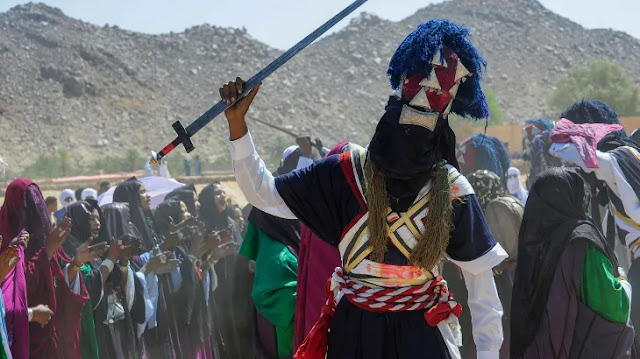Joy in the desert… Algerian Tuaregs celebrate Pharaoh’s drowning in the Sebiba festival.
The Tuaregs in the Algerian desert celebrated the annual Sebiba festival, which dates back more than 3,000 years, in an atmosphere of joy marked by traditional dance and song.
This celebration - which lasts 10 days and coincides with the anniversary of Ashura - arouses enthusiasm in the town of Ghardaia, which has 14,000 inhabitants in southeastern Algeria, where preparations continued for a week.
Hassan Cheikh (64 years old) - one of the participants in the festival that celebrates peace - explained that “the children learn to dance during the rehearsals, and everyone has the right to express their enthusiasm”, pointing out that the site that hosts the festival “exists since our ancestors”.
This celebration, listed since 2014 on the UNESCO cultural heritage list - and whose date was set by the wise men of the oasis of Ghardaia - imitates a battle between two Tuareg tribes, the Meihan and the Izlouaz.
The origins of the festival go back to a distant time, and Al Jazeera’s documentary film “The Sebiba… The Joy of the Desert” documented the celebrations of the Tuaregs between the palace of Izlouaz and the palace of Meihan, where he met their men and women who spoke of the “day of the Sebiba” and its importance and what it means to them this joyful feast.
Mokhtar Ben Omar - a dresser from the palace of Izlouaz - says in the documentary that the lunar months among the Tuaregs start with Muharram, and the tenth is called “The Sebiba”, and that the celebrations of the Sebiba go back to the story of the drowning of Pharaoh “the people tried - like the rest of the peoples of the earth - to express their joy at the death of the tyrant, and dancing with the sword was their way of expressing themselves in this valley”.
 |
| Men perform a traditional dance during the Tuareg Sebiba festival in Ghardaia (AFP) |
Ancient traditions
According to the traditions, a fierce war broke out between two tribes from the desert of Tassili n’Ajjer, located in southeastern Algeria and home to the largest museum of primitive rock paintings.
“According to our ancestors, the feast of Sebiba dates back to Pharaoh’s time and Moses in Egypt. Our ancestors kept the date of Pharaoh’s drowning in the sea and celebrated his death.”
When the two tribes learned at that time of Prophet Moses’ salvation from Pharaoh’s armies, they concluded a peace treaty, and Elias Ali, 73 years old, told AFP: “According to our ancestors, the feast of Sebiba dates back to Pharaoh’s time and Moses in Egypt. Our ancestors kept the date of Pharaoh’s drowning in the sea and celebrated his death.”
At the festival, women who adorned themselves with henna tattoos and wore heavy silver jewelry sang to the rhythm of traditional drums to stir up the atmosphere of competition that the men would face, and the woman had a great importance on the day of Sebiba, as she was the one who beat the drum “al-iminini” to announce the start of the celebrations.
Duaa (16 years old) - one of the participants in the singing - said that the jewelry “is like a woman’s ornament, she wears it with accessories”, while Sabrina (29 years old) - another singer - wore traditional clothes and a large necklace, and an elderly woman helped them with the task.
Sabrina said “There is a woman here who helps us specially to wear these clothes”, while Duaa said “We can’t wear them alone, it’s hard.”
War chants
The men who wear hats with geometric patterns pretend to face each other, waving swords - which have a special status among the Tuaregs - in one hand and scarves in the other as a sign of peace, as the real victory is to preserve the customs.
The songs and poems vary according to the neighborhoods, but most of them are praise songs, and they are received by the knights as if they were returning from the war victorious, and to the sound of war songs, the tension rises between the competitors who are fighting a peaceful symbolic war.
The process of choosing “who will be in the front and in the middle and in the back” is carried out, as Hassan Cheikh explained to the French press agency “in the Sebiba dance - especially for men - there must be a shoulder size, and the person must have muscles”.
The festival also attracts foreign tourists who came to discover the Algerian desert, such as Silke, a 55-year-old German tourist, who said “everything is special and completely different from the place I came from in Germany, from the beauty of the people and the dancers and the music and their special instruments”.





No comments